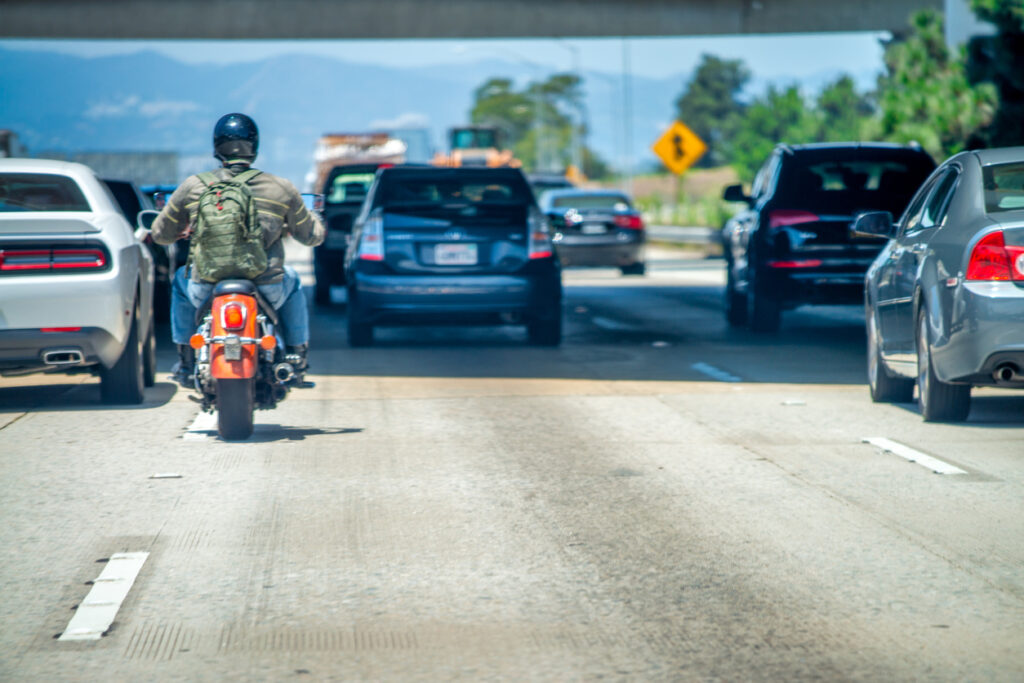Motorcycles offer a thrill, the wind in your face, the roar of the engine, the freedom of the open road. But that excitement can turn into despair in an instant. According to a 2022 report from the National Highway Traffic Safety Administration, 6,218 motorcyclists were killed, that’s 15% of all traffic fatalities that year. Additionally, an estimated 82,687 riders were injured. With numbers like that, it’s no surprise so many new motorcyclists ask, “How dangerous are motorcycles for beginners in California?” The truth is that riding will always carry risks but understanding what causes motorcycle accidents is the first step to preventing them.
Common Causes of Motorcycle Accidents

For riders, balance, coordination, judgement and braking distances can be challenging. There are several external risks that come into play, especially for beginners.
-
- Speeding
It’s no surprise that motorcycles are at their most fun when going faster, but higher speeds reduce reaction time and increase the severity of injuries. Speeding can easily result in devastating outcomes, even death, which are never worth it. - Alcohol or Drug Use
Driving under the influence is dangerous enough in a car, but on a motorcycle, the risks increase dramatically. There is little protection against any impact, so if alcohol or drugs impair a rider’s coordination, balance, and reaction time, a ticket is the least of your concern. Even a brief lapse in focus or judgement can cause a serious crash or life-altering injury. - Unsafe Lane Changes
Motorists can be unpredictable, changing lanes when you least expect it. A car unexpectedly changing lanes could result in minor injuries or damage in a 4-wheel vehicle, but for a motorcyclist, you can expect more severe injuries. A sudden merge or drift can easily lead to a serious collision. - Road Hazards
Gravel, potholes, wet roads, and debris pose a much greater threat for motorcycles. While a car might glide over a rough patch with little or no impact, motorcycles have greater risks. Even slightly poor road conditions can cause serious consequences. - Tailgating
Following too closely reduces stopping distance and rear-end collisions are especially dangerous for motorcyclists. A car bump might mean a fender bender, but for a rider, it could mean a serious injury.
- Speeding
Accidents in California are already too common, and most walk away after it, but motorcyclists might not get so lucky. Every motorist knows how important it is to follow the law, not just for the sake of avoiding a ticket, but for safety.
Lane Splitting — Legal Doesn’t Mean Safe

One of the “perks” many beginners assume about riding is the ability to weave through traffic. That practice, called lane splitting, might seem like a shortcut through congestion, especially in big cities, but it comes with serious risks. For riders wondering how dangerous are motorcycles in traffic, lane splitting is one of the clearest examples.
California Vehicle Code 21658.1, defines lane splitting as a motorcycle riding between rows of stopped or moving vehicles in the same lane. While it may seem like a smart way to save time, doing so requires precise judgment and fast reflexes, skills most beginners haven’t developed yet.
There are many reasons lane splitting is risky:
- Drivers don’t expect motorcycles between lanes and may change lanes without warning.
- Tight spacing between cars leaves little room for error. One wrong move can lead to a serious crash.
- In heavy traffic, it’s harder for drivers to spot motorcyclists, or appropriately gauge their speed.
- Road debris or even a suddenly opened door on the road can become deadly at close range.
For experienced riders, lane splitting may reduce the risk of being rear-ended, but the margin for error is dangerously thin. There’s a reason why lane splitting remains illegal in most of the United States with the exception of California and a handful of other U.S. states. But just because something is legal, doesn’t mean it’s wise. Lane splitting might save you a few minutes in traffic, but if one bad decision ends your life, those minutes aren’t worth it.
Ride Smart: Motorcycle Safety for New Riders

You’ve probably heard “safety first!” many times in your life. This is especially true when it comes to motorcycles. For anyone wondering how dangerous motorcycles are, the answer often depends on preparation. Taking the time to educate yourself, preparing your gear, and understanding your local laws can save you from getting seriously injured, or even killed.
Taking Safety Training Courses
The first step every rider should take is learning the rules and fundamentals of motorcycle operation. Good news: the California Motorcyclists Safety Program (CMSP) developed a Motorcyclist Training Course designed specifically for beginners. It includes 5 hours of classroom instruction and 10 hours on-cycle training with certified instructors.
This isn’t about checking a box. Taking a safety course gives you hands-on experience, builds your confidence, and is the first step toward getting your motorcycle license.
Wear The Right Gear Every Time
Your gear is your first line of defense in a crash. It’s not just about looks. The right protective equipment can significantly reduce the severity of injuries and even save your life. A DOT-approved helmet should be the first thing you prioritize as it can protect you from major head traumas. Additionally, abrasion-resistant materials like leather or reinforced textile protects you from road rashes. It might seem like a simple scrape, but you can easily get second or even third-degree burns if you don’t get the right protection. Even if it’s a short ride to the store down the street, gear should never be optional.
Maintain your Motorcycle
Mechanical failures on a motorcycle can be fatal. Make maintenance a regular habit — not an afterthought. Before each ride, check your tire for pressure and tread, that all lights, such as your brake lights, are working properly, and any if there are any oil leaks or loose chains. A regular serviced motorcycle runs smoother and safer. If something feels off, don’t ride until it’s checked out. Knowing your machine is part of being a responsible rider.
Even with the right training, gear, and maintenance, riding a motorcycle still carries serious risks. Accidents can happen in a split second, no matter how prepared you are. That’s why when people ask “how dangerous are motorcycles”, the answer always includes this reality: safety measures lower risks, but they never erase them.
How Dangerous Are Motorcycles When Accidents Happen and What to Do Next
You can do everything by the book: follow the law, complete a safety course, and wear the right gear, yet still find yourself in an accident. For a beginner, that moment can feel overwhelming. But you don’t have to face it alone. If you’ve recently been in a motorcycle accident, there’s a path forward. An experienced attorney can help navigate the legal process, protect your rights, and fight to secure the compensation you deserve.
